Ghats of Varanasi around river Ganges make a unique world in itself and one of the most talked about aspects from Kashi city of Uttar Pradesh. Let us take you on a quick tour of Ghats of Varanasi and explore things which make it special.
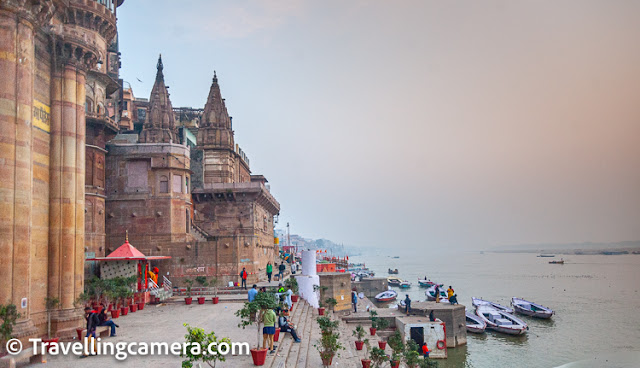
In Varanasi, a ghat is a series of steps leading down to the banks of the Ganges river. The word "ghat" is derived from the Sanskrit word "ghatam," which means a set of steps leading to a water body. The ghats of Varanasi are an integral part of the city's cultural and religious heritage, and hold great significance for the local people.
The ghats of Varanasi are considered to be the holiest places in the city, and are an important site for religious and spiritual activities. Many pilgrims come to the ghats to take a holy dip in the Ganges river, which is believed to wash away their sins and purify their soul. The ghats are also home to a number of ancient temples and shrines, including the Kashi Vishwanath Temple, one of the most important Hindu temples in India.

In addition to their religious significance, the ghats of Varanasi are also an important part of the city's cultural heritage. They are home to a range of activities and events, including cultural festivals, music and dance performances, and boat rides along the river. The ghats are also a popular spot for tourists and locals alike to relax, watch the sunrise and sunset over the river, and take in the bustling atmosphere of the city.
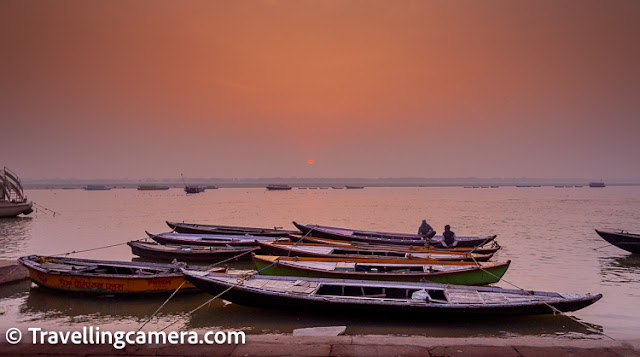
The ghats of Varanasi are an iconic and much-talked-about feature of the city, and attract visitors from all over the world. Here are some reasons why the ghats are so popular:
Spiritual significance: The ghats of Varanasi are an important spiritual and religious site, with many pilgrims coming to take a holy dip in the Ganges river and perform rituals and ceremonies.
Cultural heritage: The ghats of Varanasi are an important part of the city's cultural heritage, with a history that dates back several centuries. Many of the ghats have been named after rulers, saints, and historical figures, and are home to ancient temples and shrines.
Spectacular views: The ghats offer some of the most spectacular views of the Ganges river and the city of Varanasi. Visitors can watch the sunrise and sunset over the river, and see the city come alive with activity.
Activities and events: The ghats of Varanasi are home to a range of activities and events, including religious ceremonies, cultural festivals, and boat rides along the river.
Photo opportunities: The ghats of Varanasi offer endless opportunities for photography, with the colorful boats, ancient temples, and bustling crowds providing a rich visual tapestry.
Varied experiences: Each ghat in Varanasi has its own unique character and atmosphere, offering visitors a varied and immersive experience of the city's culture and heritage.

There are many ghats in Varanasi, each with its own unique name and significance. Here are some of the most well-known ghats of Varanasi: Assi Ghat ,Dasaswamedh Ghat ,Manikarnika Ghat ,Harishchandra Ghat ,Kedar Ghat ,Scindia Ghat ,Tulsi Ghat, Chet Singh Ghat, Chaushat Ghat, Raj Ghat, Shivala Ghat, Manmandir Ghat, Bachraj Ghat, Adi Keshava Ghat, Panchganga Ghat...
Each ghat in Varanasi has its own unique history and significance, and many are named after religious figures, historical events, or local landmarks. The ghats of Varanasi are an important part of the city's cultural and religious heritage, and hold great significance for the local people.

The best time to walk around the ghats of Varanasi is early in the morning, just before sunrise. This is when the city is at its most peaceful and the weather is relatively cool, making it an ideal time for walking and exploring. The morning also offers a chance to witness the daily rituals and ceremonies that take place on the ghats, such as the chanting of mantras and the offering of prayers.
Another good time to walk around the ghats is in the evening, just before sunset. This is when the ghats come alive with activity, with crowds of people gathering to watch the aarti ceremony, a Hindu ritual in which lamps are lit and offerings are made to the Ganges river.
It's important to note that the ghats can be crowded and busy at any time of day, so it's a good idea to take care while walking around, especially near the water's edge. It's also important to dress appropriately, covering your head and shoulders as a sign of respect for the local customs and traditions.

Boating is a popular activity around the ghats of Varanasi, offering a unique perspective on the city's cultural and religious heritage. There are several options for boating around the ghats, ranging from small rowboats to larger motorized boats. Here are some of the most popular boating options around Varanasi's ghats:
Rowboats: Rowboats are a traditional way of exploring the ghats of Varanasi. These small, wooden boats are powered by oars and can accommodate up to four passengers. They are a quiet and peaceful way to explore the river, and offer an up-close view of the ghats and the city's many temples and shrines.
Motorized boats: Motorized boats are a faster and more convenient way to explore the ghats. These boats are equipped with motors and can accommodate larger groups of passengers. They are ideal for longer trips along the river, and offer a comfortable way to explore the city's many landmarks and attractions.
Sunrise and sunset boat rides: Sunrise and sunset boat rides are a popular way to experience the ghats of Varanasi. These boat rides typically last for an hour or so and offer a chance to see the city's many temples and shrines as the sun rises or sets over the river.
Private boat tours: Private boat tours are a great option for those who want a more personalized experience of the ghats. These tours can be customized to suit individual interests and preferences, and offer a chance to explore the city's many landmarks and attractions at your own pace.
Boating around the ghats of Varanasi is a unique and memorable experience, offering a chance to see the city from a different perspective and to learn more about its rich cultural and religious heritage.
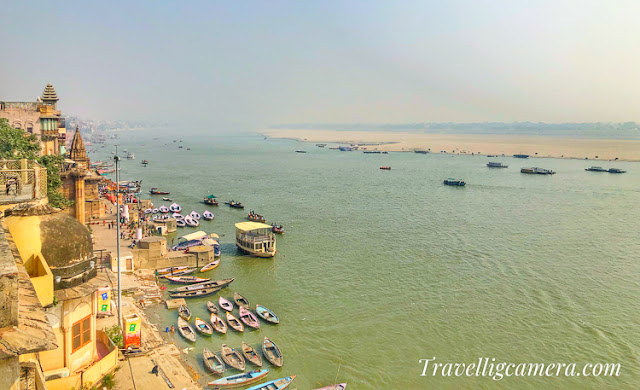
The Ganges River, or the Ganga as it is known in India, is a sacred and important river for Hindus, and Varanasi is one of the most important cities along its banks. However, the river has been heavily polluted over the years due to various factors such as industrial waste, sewage, and garbage dumping.
To address this issue, various initiatives have been undertaken to clean the Ganga in Varanasi. In 2014, the Indian government launched the Namami Gange project, a national mission aimed at cleaning and conserving the Ganga river. As part of this project, a number of initiatives have been undertaken in Varanasi, including:
Construction of sewage treatment plants: Several sewage treatment plants have been constructed in Varanasi to treat the waste water that flows into the Ganga river.
Installation of garbage traps: Garbage traps have been installed at various points along the river to prevent the accumulation of plastic and other waste.
Ban on single-use plastics: The use of single-use plastics has been banned in Varanasi to reduce the amount of plastic waste that ends up in the river.
Awareness campaigns: Various awareness campaigns have been launched to educate the local community and visitors about the importance of keeping the Ganga clean and reducing pollution.
While these initiatives have had some impact on improving the cleanliness of the Ganga in Varanasi, much more needs to be done to fully restore the health of the river. The government, local authorities, and communities must work together to continue the efforts to clean the Ganga and ensure that it remains a source of life and livelihood for generations to come.
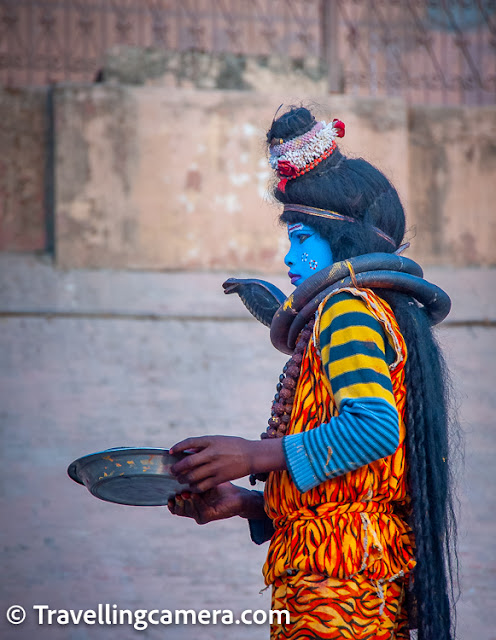
Bahrupiyas are a unique and fascinating feature of the cultural landscape of Varanasi, one of the oldest and holiest cities in India. These skilled impersonators can transform themselves into anyone, from famous movie stars and politicians to mythological characters and animals. They roam the ghats, the series of steps leading down to the banks of the Ganges river, and offer their services to the crowds of pilgrims and tourists that visit the city. Many of them have inherited the profession from their ancestors, and they take great pride in their artistry and ability to captivate audiences. They use makeup, wigs, costumes, and props to create their illusions, and their performances range from comedic to serious and thought-provoking. Despite the challenges they face in a rapidly changing world, the bahrupiyas of Varanasi continue to enchant and amaze visitors with their skill and creativity.
While bahrupiyas in Varanasi are known for their ability to impersonate famous personalities, there are also those who offer simpler services such as putting tilak on the forehead for a small fee. For as little as 10 rupees, these bahrupiyas will adorn your forehead with the sacred mark, which is a common practice among Hindus. The tilak is believed to bring good luck and ward off evil spirits, and it is often applied during religious ceremonies or before embarking on a journey. For many visitors to Varanasi, receiving the tilak from a bahrupiya on the ghats is a memorable and authentic cultural experience. It's not just the act of getting the tilak, but the interaction with the bahrupiya and the opportunity to learn more about their traditions and way of life that make the experience truly special.
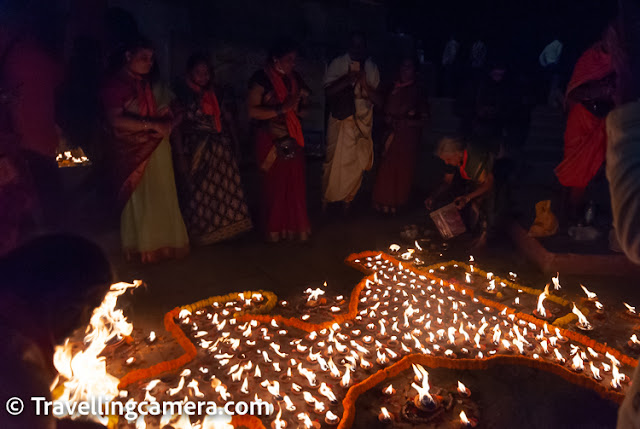
One of the popular rituals performed by South Indians in Varanasi is the lighting of lamps or diyas on the ghats of the Ganges river. This is known as the "Deepa Aradhana" ceremony, which is usually performed by devotees from Tamil Nadu, Andhra Pradesh, and Karnataka.
During this ceremony, thousands of lamps are lit along the ghats, creating a beautiful and mesmerizing sight. Devotees offer prayers to the river and light lamps in honor of the gods and goddesses. The lamps are typically made of clay or brass and are filled with ghee or oil. The wicks are made of cotton or silk and are dipped in the ghee or oil before lighting.
The Deepa Aradhana ceremony is performed during the month of Karthikai, which falls in November or December, and is considered a highly auspicious time for lighting lamps. The ceremony is believed to bring prosperity, peace, and happiness to the devotees and their families.
Overall, the Deepa Aradhana ceremony is a beautiful and awe-inspiring sight that attracts both locals and tourists alike. It is a testament to the rich diversity of religious and cultural traditions that can be found in Varanasi, making it a truly unique and special place to visit.
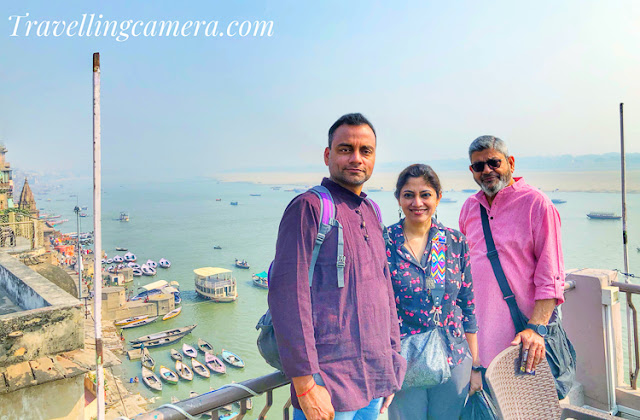
There are several hotels in Varanasi that offer panoramic views of the ghats, providing guests with a breathtaking view of the Ganges river and the surrounding city. Above photograph is clicked on rooftop of Hotel Sita near Munshi Ghat of Varanasi.
Here are some of the hotels in Varanasi with panoramic views of the ghats:
BrijRama Palace: This luxurious heritage hotel is located right on the banks of the Ganges river, providing guests with stunning views of the ghats. The hotel has a rooftop terrace where guests can enjoy panoramic views of the river and the surrounding city.
Taj Nadesar Palace: This elegant hotel is situated on the outskirts of the city, surrounded by lush gardens and offering stunning views of the ghats. The hotel has a beautiful rooftop terrace where guests can enjoy a cup of tea or a cocktail while taking in the panoramic views.
Suryauday Haveli: This charming hotel is located on the Shivala Ghat and offers panoramic views of the river and the ghats. The hotel has a rooftop terrace where guests can enjoy a meal or a drink while taking in the breathtaking views.
Rivatas by Ideal: This modern hotel is located in the heart of the city and offers panoramic views of the ghats from its rooftop restaurant. Guests can enjoy a meal while watching the sunset over the river.
Hotel Alka: This budget-friendly hotel is located on the Assi Ghat and offers panoramic views of the river and the ghats from its rooftop terrace. Guests can enjoy a cup of tea or a meal while taking in the beautiful views.

The ghats of Varanasi are the site of many important rituals and ceremonies that are an integral part of the city's religious and cultural heritage. Here are some of the most common rituals that take place around the ghats:
Bathing in the Ganges: One of the most important rituals in Varanasi is bathing in the Ganges river. Hindus believe that bathing in the river washes away their sins and purifies their soul. Devotees can often be seen taking a dip in the river at dawn, particularly on auspicious days such as Mondays, during the Kumbh Mela festival, and during the annual Shivaratri festival.
Aarti ceremony: The aarti ceremony is a daily ritual that takes place at sunset on the ghats of Varanasi. During the ceremony, priests offer prayers and light lamps to the Ganges river, accompanied by the singing of hymns and the ringing of bells. The aarti ceremony is a beautiful and uplifting experience that attracts large crowds of visitors and devotees.
Cremation rituals: The ghats of Varanasi are also the site of cremation rituals, as Hindus believe that cremation at the banks of the Ganges brings salvation to the departed soul. The Manikarnika and Harishchandra ghats are particularly famous for these rituals, and visitors can often see funeral pyres burning on these ghats.
Puja ceremonies: Puja ceremonies are a common sight on the ghats of Varanasi, with devotees offering prayers and performing rituals to various deities. These ceremonies are often performed by priests, who use offerings such as flowers, incense, and sweets to honor the gods.
Yoga and meditation: The ghats of Varanasi are also a popular spot for yoga and meditation. Many yoga and meditation centers offer classes and workshops on the ghats, allowing visitors to experience the peaceful and spiritual atmosphere of this holy city.
These are just a few examples of the many rituals and ceremonies that take place around the ghats of Varanasi. The ghats are a vibrant and spiritual place, offering a glimpse into the rich cultural and religious traditions of this ancient city.
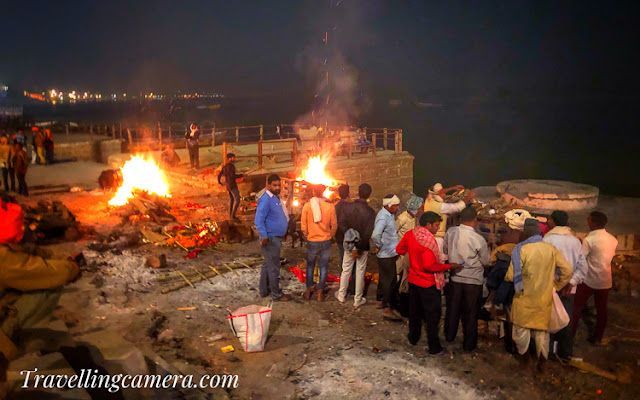
Manikarnika Ghat is one of the most well-known and important ghats in Varanasi. It is considered to be the main cremation ghat in the city and is believed to be one of the holiest places in India. According to Hindu mythology, it is said that Lord Vishnu created the ghat by digging a well with his discus or Sudarshan Chakra.
It is estimated that over 200 bodies are cremated at Manikarnika Ghat every day, and the ghat is always busy with funeral processions, mourners, and priests performing rituals. The ghat is also known as the "burning ghat" or "cremation ghat" because of its association with the cremation of the dead.
Despite its association with death and cremation, Manikarnika Ghat is also considered to be a place of spiritual significance and pilgrimage. Many people come to the ghat to bathe in the Ganges river and perform puja or prayer rituals. It is believed that by bathing in the river and performing rituals at Manikarnika Ghat, one can achieve spiritual purification and liberation.
However, it is important to be respectful and mindful when visiting Manikarnika Ghat, as it is a place of great importance and sensitivity for many Hindus. Visitors are advised to dress modestly, refrain from taking photographs, and follow the instructions of local authorities and priests.

Varanasi is a city with a rich and storied history, and the ghats along the Ganges river are home to many ancient structures that tell the tale of its past. One such structure is the Dashashwamedh Ghat, which is said to have been built by Lord Brahma to welcome Lord Shiva. The ghat is home to a grand aarti ceremony that takes place every evening, where devotees offer prayers to the river goddess and seek blessings. Another iconic structure is the Manikarnika Ghat, which is believed to be one of the oldest and holiest in Varanasi. It is said that the ghat was created by Lord Vishnu, and it is known for its burning ghats where the dead are cremated. Other notable structures include the Kashi Vishwanath Temple, which is dedicated to Lord Shiva and is one of the 12 Jyotirlingas in India, and the Alamgir Mosque, which was built by Mughal Emperor Aurangzeb in the 17th century. The city of Varanasi has been a center of learning and culture for thousands of years, and the ancient structures around the ghats stand as a testament to its rich and diverse past.
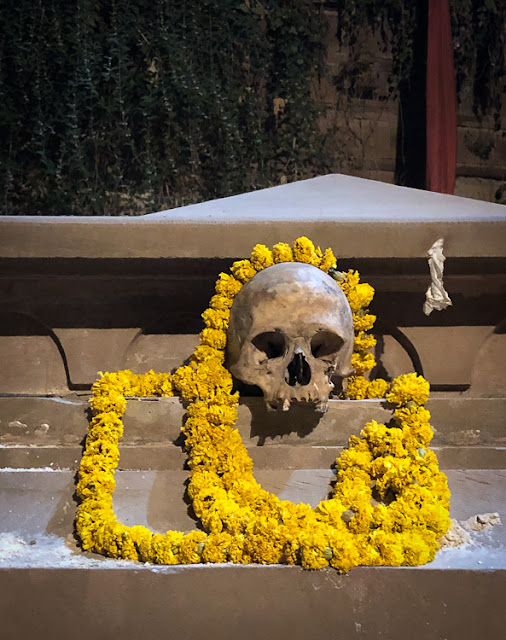
It is not uncommon to see skulls or human remains on the ghats of Varanasi. This is because Varanasi is considered one of the holiest cities in India, and according to Hindu beliefs, it is believed that if a person is cremated in Varanasi and their ashes are scattered in the Ganges river, they will achieve Moksha, or liberation from the cycle of birth and death.
As a result, many people from all over India bring their deceased loved ones to Varanasi for cremation, and it is estimated that over 200 people are cremated on the ghats of Varanasi every day. After the cremation, the ashes are often scattered in the Ganges river, and sometimes, the remains of the body are left on the ghats.
While it may seem strange to outsiders, for many Hindus, the presence of human remains on the ghats is seen as a sign of the spiritual significance and power of Varanasi. In fact, some people believe that by seeing human remains on the ghats, they can receive blessings and purify their souls.
It is worth noting that the Indian government and local authorities have taken steps to improve the sanitation and hygiene of the ghats, and many efforts have been made to ensure that the cremation process is done in a safe and respectful manner.

One of the unique cultural experiences to be had in Varanasi is taking a bath in a kund with soil. A kund is a small rectangular tank or reservoir that is often found near temples or on the ghats. The soil bath is a traditional practice that is believed to have purifying and healing properties. To take a soil bath, one must first purchase a small packet of soil from a vendor near the kund. The soil is mixed with water in the kund, and then bathers immerse themselves and rub the soil all over their bodies. The experience is said to be refreshing and invigorating, and many people believe it can help alleviate skin conditions and other ailments. One of the most popular kunds for soil baths is the Lalita Ghat Kund, which is located near the Manikarnika Ghat. While the practice may seem unusual to outsiders, it is an important part of the culture and traditions of Varanasi, and many visitors find it to be a memorable and authentic experience.

If you have ever visited the ghats of Varanasi, you might have noticed the priests sitting under colorful umbrellas, offering their services to the devotees. These umbrellas are called "chhatris" and they serve as a symbol of protection and respect for the priests who sit under them. The priests provide a range of services, from performing puja and offering prayers to the river goddess, to performing rituals for the deceased and conducting astrology readings. They are an integral part of the spiritual life of the city and are highly respected by the locals. The chhatris themselves are often decorated with intricate designs and bright colors, adding to the lively and vibrant atmosphere of the ghats. While the services offered by the priests may vary, the experience of sitting under a chhatri and receiving a blessing or a ritual is a must-try for anyone visiting Varanasi. It's a unique and memorable way to connect with the local culture and traditions of the city.
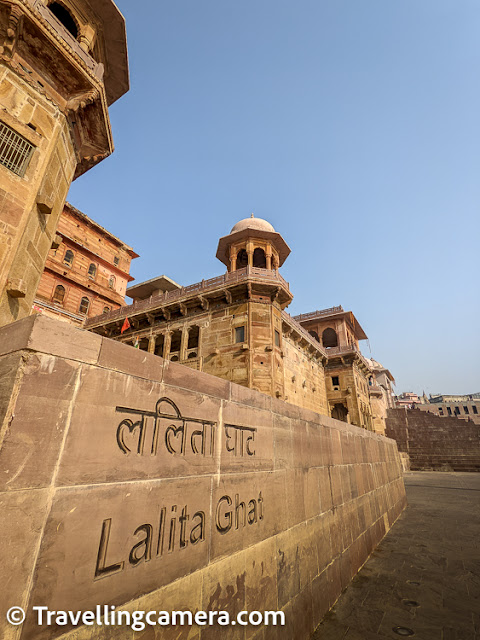
Taking a morning walk around the ghats of Varanasi is a must-do experience. It offers a chance to witness the sunrise over the Ganges river, witness the ghats come alive with activity, escape the crowds, connect with the city's spiritual side, and enjoy the stunning scenery. It's a unique and memorable way to experience the culture, spirituality, and natural beauty of the city, and offers a peaceful respite from the hustle and bustle of the day.

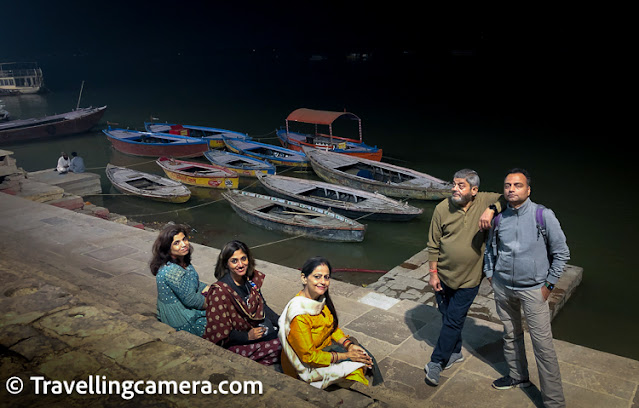





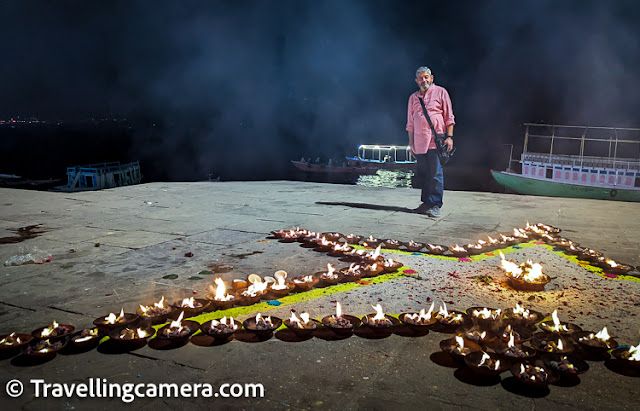


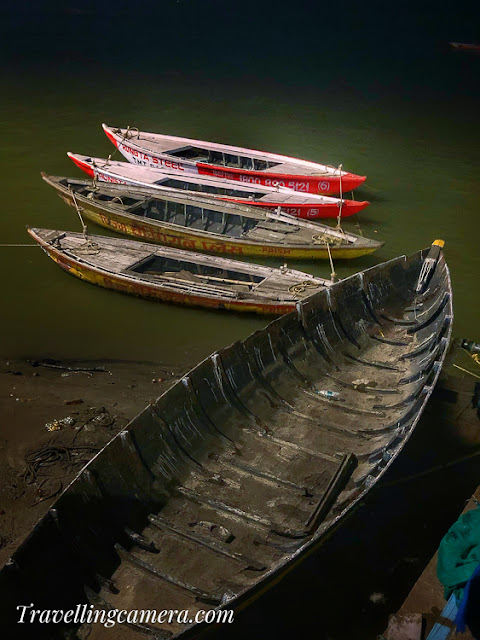



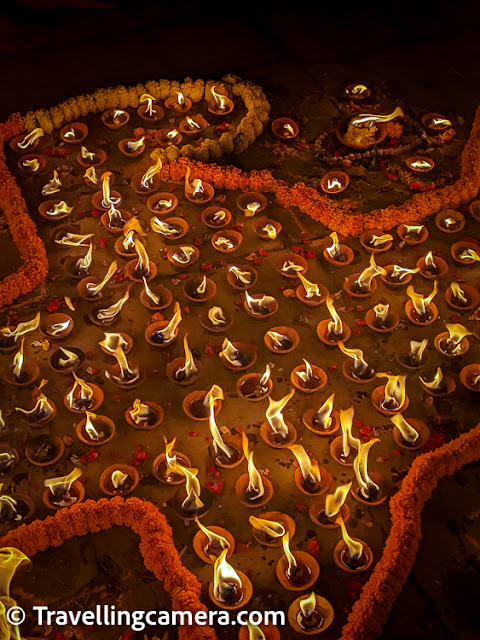

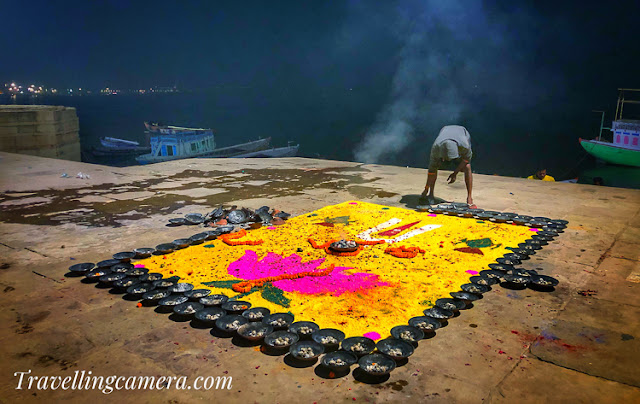





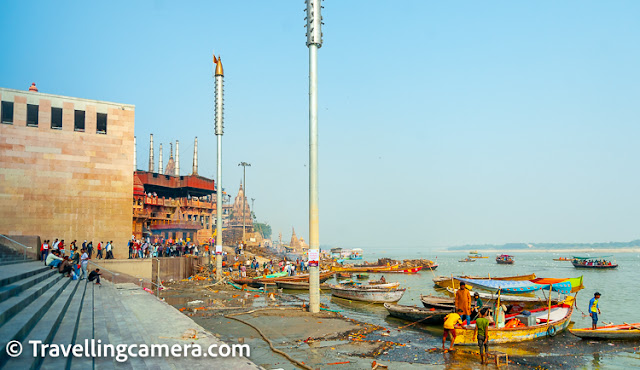





















.jpg)
Comments